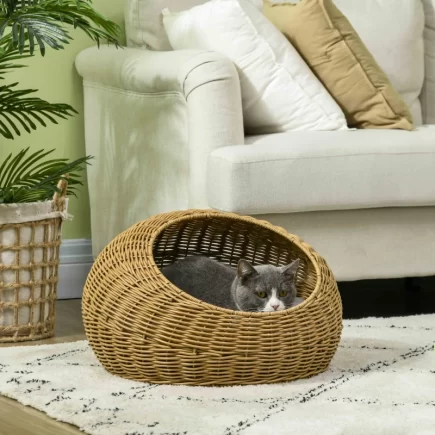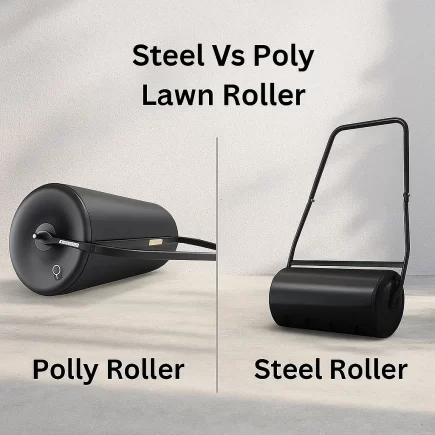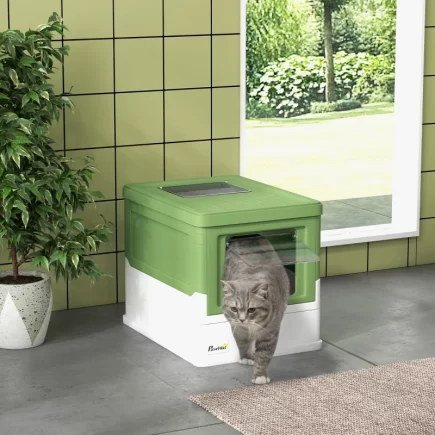Keeping your cat’s bed clean isn’t just about appearance, it’s about their health. Cat beds collect hair, oils, odors, bacteria, and allergens much faster than most owners realize. A fresh, well-cleaned bed helps your cat breathe easier, sleep better, and stay more comfortable every day.

This simple guide shows you exactly how to clean any type of cat bed step-by-step, how to handle tough smells and stains, and how to care for fabric, foam, and wicker frames safely. Whether your cat sheds a lot, has allergies, or just loves their favorite spot, these tips will help you keep their sleeping space fresh and healthy with minimal effort.
Step 1: Remove Hair and Loose Debris
This step improves the effectiveness of both machine and hand washing.

How to Remove Debris
- Take out the cushion and shake the bed outside to loosen dust and hair.
- Use a vacuum with upholstery or crevice attachments for seams and corners.
- Lift remaining fur using lint rollers, tape, or damp rubber gloves, depending on the fabric’s texture.
Step 2: Check the Label and Identify Washable Parts
Every cat bed is constructed differently, so care labels should always guide your next steps.
Common Label Instructions
| Label | Meaning |
| Machine-washable | Safe on cold, gentle, or delicate cycle |
| Hand-wash only | Foam or padding should not go in the washer |
| Remove cover | Only the fabric cover is washable |
| Low heat / air dry | Prevents shrinking or material breakdown |
| Do not bleach | Bleach damages fabric and reacts with urine |
Washability Overview
- Fabric covers: Typically machine-safe
- Poly-fill cushions: Usually machine-safe
- Memory foam: Hand wash only
- Orthopedic foam: Hand wash and air dry
- Heated bed covers: Washable after removing wiring
- Wicker or rattan: Wipe with mild soap only
- Faux fur / sherpa: Gentle cycle or hand wash
When in doubt, washing by hand is the safest approach
Step 3: Spot Clean Stains Safely
Treat stains before washing to prevent them from setting.

Pet-Safe Stain Solutions
- Enzyme cleaners break down urine, vomit, and organic debris.
- Vinegar diluted with water reduces odors and softens dried residue.
- Baking soda absorbs moisture and neutralizes mild smells.
- Hydrogen peroxide can be used carefully on light-colored fabrics for blood or organic stains.
Let your chosen cleaner sit for 10–20 minutes before washing.
Step 4: Machine Wash the Bed

| Step | Instruction |
| 1 | Wash covers separately from clothing or other laundry |
| 2 | Use cold water on a gentle or delicate cycle |
| 3 | Choose unscented, hypoallergenic detergent |
| 4 | Run an extra rinse to remove residue |
| 5 | Add vinegar to the rinse cycle for lingering odors |
| 6 | Repeat cycle only if the bed is heavily soiled |
Step 5: Hand Wash Cat Beds That Aren’t Machine-Safe
Foam and certain delicate materials require a gentler approach.
Hand Washing Method
- Fill a tub or sink with cold or lukewarm water.
- Add a small amount of mild, fragrance-free detergent.

- Submerge the bed or insert and gently press to work the cleaner through.

- Drain the water, refill with clean water, and rinse until suds disappear.
- Press out excess water without twisting the material.
This method protects the structure of foam and prevents tearing or misshaping.
Step 6: Kill Fleas, Bacteria, and Odors
This step is important for homes dealing with pests, strong odors, or skin sensitivities.
Effective Methods
- Hot water helps eliminate bacteria and flea eggs, but only when the fabric label permits.
- Vinegar in the rinse cycle provides mild disinfection.
- Thoroughly vacuuming the bed area removes hidden debris.
- Place washable components in the dryer on low heat if they are dryer-safe.
- Air-drying foam in direct sunlight helps reduce odors and organic residue.
Odor Removal Soak
For deep odors, soak the bed in:
- 2 tablespoons baking soda
- 1 gallon cold water
- Soak for 20 minutes before washing
How to Clean a Wicker Cat Bed Frame
Wicker and water-hyacinth cat bed frames need gentler care than fabric or foam. They should never be soaked or machine-washed, as too much moisture can cause swelling, mold, or fiber damage.
Use these simple steps to clean them safely:
1. Remove debris:
Take out the cushion, shake the frame outdoors, and vacuum the inside and edges with a brush attachment.
2. Wipe the surface:
Use a lightly damp microfiber cloth with mild soap or pet-safe cleaner. Wipe gently along the weave without soaking the fibers.
3. Clean tight areas:
Use a soft toothbrush or detailing brush to remove dirt trapped between woven strands.

4. Disinfect lightly (optional):
Wipe with a cloth dipped in a diluted vinegar mix (1:3 vinegar to water). Never spray liquid directly on the wicker.
5. Dry completely:
Place the frame in a ventilated room or indirect sunlight for 1–2 hours. Avoid strong direct sun, which can make fibers brittle.
6. Deodorize if needed:
Sprinkle baking soda inside the pod, let it sit for up to an hour, then vacuum thoroughly.
Step 7: Dry the Bed Properly
Drying must be done completely to prevent moisture buildup and mold.
Drying Methods by Material
| Material | Drying Method |
| Fabric covers | Low-heat dryer or air dry |
| Poly-fill | Low heat; avoid over-drying |
| Memory foam | Air dry only |
| Orthopedic foam | Air dry in well-ventilated area |
| Heated bed covers | Follow label; air dry or low heat |
Best Practices
- Lay foam on a clean towel and flip occasionally.
- Dry outdoors when weather allows to speed up the process.
- Thick foam inserts may require 24–48 hours.
How Often You Should Clean a Cat Bed
The right cleaning frequency depends on shedding, lifestyle, and how quickly odors develop.
Recommended Cleaning Frequency
| Cat Type or Lifestyle | Shedding Level | How Often to Wash |
| Indoor, short-hair | Low–moderate | Every 2–4 weeks |
| Indoor, long-hair | High | Every 1–2 weeks |
| Indoor/outdoor | Moderate–high | Weekly |
| Senior or health-sensitive | Varies | Every 7–10 days |
| Kittens | Moderate | Weekly |
| Allergy-prone households | Moderate | Weekly–biweekly |
| Multi-cat households | High | Weekly |
Tips for Sensitive-Skin, Older, or Allergy-Prone Cats
Special-care cats often benefit from gentler cleaning methods.
Helpful Practices
- Always choose fragrance-free detergent.
- Rinse bedding thoroughly to avoid residue.
- Avoid essential oils or heavily scented products.
- Use soft, breathable fabrics like fleece or cotton.
- Double-check that everything is fully dry before use.
These steps reduce irritation and help sensitive cats feel more comfortable.
How to Clean Different Types of Cat Beds
Each material requires a specific cleaning approach.
Material Cleaning Guide
| Bed Material | Cleaning Method |
| Faux fur | Gentle cycle or hand wash; air dry |
| Sherpa | Hand wash or delicate cycle; avoid high heat |
| Plush | Machine wash cold; low-heat dry |
| Polyester fill | Machine wash cold; tumble low |
| Memory foam | Hand wash; allow full air drying |
| Orthopedic foam | Hand wash; dry in ventilated area |
| Wicker/rattan | Wipe with mild soap; air dry completely |
| Heated beds | Remove heating pad; wash cover only |
Proper care preserves the bed’s shape, feel, and longevity.
How to Choose an Easy-to-Clean Cat Bed Next Time
Choosing the right bed makes future cleaning much simpler.
Features That Simplify Cleaning
- Removable machine-washable covers
- Waterproof or water-resistant liners
- Beds without deep crevices
- Fabrics that release hair easily
- Replaceable inserts or cushions
- Smaller sizes that fit standard washing machines
These features reduce future cleaning time and extend the bed’s lifespan.
When to Replace a Cat Bed
Even with proper care, all beds eventually wear out.
Signs It’s Time to Replace
- Persistent odors even after cleaning
- Mold or mildew spots
- Flattened or crumbling foam
- Torn seams or loose stuffing
- Stains that return quickly
- The bed remains damp after washing
A new bed ensures better hygiene, comfort, and safety.
Cleaning your Cat’s Bed doesn’t have to be complicated. With the right routine and cleaning approach, you can maintain a fresh, healthy sleeping space that supports your cat’s comfort year-round. By understanding how to clean different materials, how often to wash, and how to maintain the bed between cleanings, you’ll keep both your home and your cat feeling their best.
FAQs
1. Do heated cat beds need special cleaning care?
Yes. Always remove the heating element before cleaning. Never submerge it, and only wash the cover. Wipe the heating pad with a slightly damp cloth if needed.
2. What if the bed still smells after washing it?
That usually means odor is trapped in the foam. Soak the cover or foam (if safe) in a baking-soda solution for 20 minutes, rinse well, and make sure it dries fully from the inside out.
3. What should I do if my cat refuses to sleep in the bed after I wash it?
Cats avoid strong scents. Wash again with fragrance-free detergent, skip fabric softeners, and let the bed air out for a day. Rubbing a blanket or towel with your cat’s scent helps them accept it again.





























